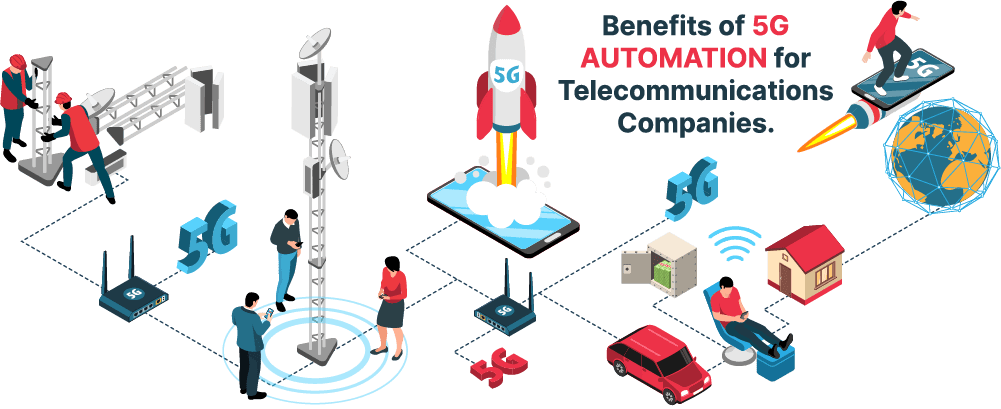Does 5G technology promise a significant leap in connectivity within the telecommunications industry, reshaping communication, collaboration, and innovation?
With an escalating demand for more dependable networks, does strategic planning for deploying 5G networks take notable importance?
Does it highlight that navigating the complexities of 5G demands a strategic use of automation in a new era of telecommunications?
This guide explores 5G, uncovering the essential components of a robust NMS. It empowers telecom professionals, architects, and decision-makers with insights for strategic and seamless 5G deployment.
Related blog: How NMS Enhances Fault Detection and Resolution for Better Telecom Network Reliability?
5G & Network Automation
Integrating 5G technology and network automation signifies a shift in telecommunications. As the industry navigates the dynamic change of 5G, the strategic deployment of advanced network automation emerges as a crucial element for operational excellence. This section delves into the profound influence of 5G on the telecommunications sector that has played by network automation in enhancing performance.
Challenges in 5G Networks
The emergence of 5G technology has brought about a significant shift in the telecommunications industry, presenting both unique opportunities and challenges. Understanding the dynamics within the industry and the specific hurdles telecom operators face is pivotal for navigating this competitive world.

Industry Dynamics:
The telecommunications sector is experiencing a profound shift as it embraces the capabilities of 5G. Let’s delve into the dynamics shaping this transition:
- Infrastructure Upgrades: Explore the substantial investments and upgrades required in infrastructure to support the deployment of 5G networks. Understand the implications of these upgrades on existing telecom frameworks and their influence on network capabilities.
- Shifting Business Models: Examine how the introduction of 5G reshapes traditional business models in the telecommunications industry. Consider the emergence of new revenue streams and business opportunities driven by the capabilities of 5G technology.
Special Challenges
The deployment and management of 5G networks pose unique challenges for telecom operators. This section offers a detailed exploration of these challenges:
- Heightened Network Complexity: Analyze the increased complexity of 5G networks, including integrating various technologies and managing diverse network elements. Understand how operators navigate the complexities of a more sophisticated network architecture.
- Managing Increased Data Volumes: Explore the challenges associated with the exponential growth in data volumes facilitated by 5G technology. Examine strategies employed by operators to handle and process the massive amounts of data transmitted across 5G networks.
- Ensuring Security and Reliability: Delve into the critical aspects of ensuring the security and reliability of 5G networks. Discuss the unique security challenges posed by 5G, such as increased attack surfaces and the need for robust protective measures.
- Regulatory and Standards Compliance: Understand the regulatory landscape surrounding 5G deployment and how operators navigate compliance with industry standards. Explore the complexities of adhering to regulatory requirements while ensuring the optimal performance of 5G networks.
- Spectrum Management: Examine the challenges related to spectrum allocation and management in the 5G ecosystem. Discuss how operators optimize spectrum resources to meet the diverse demands of 5G services.
In the exploration, gaining insights into the industry dynamics guiding the adoption of 5G networks and the challenges that telecom operators confront in their pursuit of seamless 5G network deployment and operation.
Addressing 5G Challenges: The Role of Network Management Systems
The advent of 5G technology brings unprecedented opportunities but also introduces many challenges that require robust solutions. NNMS plays a pivotal role in overcoming these challenges. Here, we explore how NMS addresses critical challenges in the 5G environment.
- Dynamic Slice Management: NMS offers dynamic network slice creation, management, and orchestration to assure optimal resource allocation, quality of service enforcement, and seamless integration of diverse services within a shared infrastructure.
- Real-time Analytics: NMS components specialize in monitoring and optimizing millimeter-wave spectrum by employing real-time analytics to identify optimal frequency bands, mitigate interference, and maximize data rates.
- Configuration Tools: NMS components provide tools for configuring and managing Massive MIMO systems, addressing challenges related to deployment, and optimizing the utilization of multiple antennas for improved coverage and capacity.
- Dynamic Service Management: NMS components dynamically manage and optimize services with ultra-low latency requirements, integrating edge computing resources seamlessly to support latency-sensitive applications.
- Precision Time Protocol (PTP) Management: NMS components manage PTP and frequency synchronization, ensuring coordinated communication and preventing issues related to timing discrepancies in 5G networks.
- Security Policy Enforcement: NMS components manage and enforce security policies specific to 5G network elements, interfaces, and protocols, incorporating intelligent threat detection mechanisms to identify and quickly respond to security threats in real time.
By addressing the complexities, NMS proves to harness the full potential of 5G networks. As the 5G continues to evolve, the role of NMS remains pivotal in providing a resilient and secure foundation for the future of telecommunications.
Transformative Impact of Automation
In the telecom industry, automation’s transformative impact reshapes traditional paradigms and enhances reliability.
- Automation Solutions: Automation solutions are at the forefront of addressing the unique challenges telecom operators face in managing complex networks, especially in the era of 5G. Here’s an overview of crucial automation solutions driving this transformative change:
- Network Orchestration: Network orchestration involves the automated coordination and management of various network elements to deliver seamless services.
Impact: Enhances service agility, accelerates deployment, and confirms optimal resource utilization.

- AI-Driven Analytics: AI and analytics automate data analysis to derive actionable insights for predictive maintenance and performance optimization.
Impact: Enables proactive issue resolution, minimizes downtime, and enhances overall network performance.
- Zero-Touch Provisioning: Automation of end-to-end provisioning processes without manual intervention.
Impact: Drastically reduces provisioning time, accelerates service delivery, and minimizes the risk of human errors.
- Self-Healing Networks: Automated detection and resolution of network issues without human intervention.
Impact: Improves network reliability, minimizes service disruptions, and enhances the overall user experience.
- Service Orchestration: Coordinates the delivery of multiple services across diverse network domains.
Impact: Streamlines service creation, modification, and deletion, ensuring flexibility and adaptability to changing demands.
- Automated Security Protocols: Implementing automatic security measures to detect and respond to potential threats.
Impact: Enhances network security, safeguards sensitive data, and ensures compliance with regulatory standards.
- Intelligent Resource Allocation: Automation of resource allocation based on real-time demand and usage patterns.
Impact: Optimizes resource utilization, reduces operational costs, and supports dynamic scalability.
As telecom operators embrace the transformative power of automation solutions, they pave the way for a resilient and adaptive network infrastructure capable of meeting the demands of the 5G era and beyond.
Benefits of 5G Automation for Telecommunications Companies.

The integration of 5G technology with automation presents a multitude of benefits for telecommunications companies. These advantages extend across various aspects of their operations, enhancing productivity, scalability, and the overall customer experience. Here are some key benefits of 5G automation for telecommunication companies:
- Operational Cost Reduction: Automation streamlines various operational processes, reducing the need for manual intervention. This can result in significant cost savings for telecommunication companies by optimizing resource utilization and minimizing human labor requirements.
- Energy Savings: Automated systems can optimize energy consumption in network operations, contributing to lower operational costs and increased sustainability. This is particularly important as it becomes a critical consideration in the era of high-performance 5G networks.
- Agile Network Configuration: Automation facilitates quick and flexible network configuration, allowing telecommunication companies to deploy new services rapidly. This agility is crucial for staying competitive and meeting the growing demands of customers for innovative and diverse services.
- Faster Time-to-Market: Automated processes enable telecommunications companies to bring their services to market, giving them a competitive edge in the dynamic and fast-paced telecommunications industry.
- Real-time Monitoring and Optimization: Automation tools continuously monitor network performance in real-time and can automatically optimize configurations for better quality of service. This leads to improved reliability and a consistently high level of network performance.
- Proactive Issue Resolution: Automated systems can detect and address potential issues before they impact service quality. This proactive approach minimizes downtime and enhances overall network reliability.
- Network Slicing for Customized Services: 5G automation enables telecommunication companies to offer customized services through network slicing. This allows them to tailor services to specific user needs, providing a more personalized and satisfying customer experience.
- Faster Problem Resolution: Automated systems can quickly identify and address network issues, leading to faster problem resolution and minimizing customer disruptions. This improves customer satisfaction and loyalty.
Incorporating 5G automation empowers telecommunication companies to operate more securely, deploy services faster, enhance network quality, and deliver an improved customer experience. These benefits position them to thrive in an era of rapid technological advancement and increasing customer expectations.
Advanced NMS for 5G Networks
As 5G technology evolves, productive network management becomes paramount. Advanced NMS are crucial in optimizing the performance, reliability, and security of 5G networks. Explore an advanced NMS’s key features and capabilities tailored for 5G networks.
- Customized Resource Allocation: Advanced NMS for 5G incorporates dynamic network slicing capabilities. This allows operators to create and manage virtual slices of the network, each customized to meet specific performance requirements. It maintains optimal resource allocation for diverse services, from ultra-reliable low-latency communication (URLLC) to massive machine-type communication (MTC).
- Predictive Maintenance: Leveraging real-time analytics, advanced NMS can predict potential network issues before they occur. Automated processes initiate preventive measures, reducing downtime and enhancing overall network reliability. This proactive approach to maintenance is crucial in ensuring uninterrupted 5G service delivery.
- Comprehensive Monitoring: Advanced NMS provides end-to-end visibility across the 5G network infrastructure. This includes monitoring radio access, core network, and backhaul elements. Complete visibility allows operators to identify and address performance bottlenecks and optimize network performance quickly.
- Flexible Service Orchestration: An advanced NMS for 5G utilizes policy-driven orchestration to dynamically adapt to changing network conditions and service demands. This confirms that services are delivered by predefined policies, maintaining a consistent quality of service and allowing for seamless scaling.
- Behavioral Analytics: In the face of evolving cybersecurity threats, advanced NMS incorporates intelligent security measures, including behavioral analytics. The system can identify abnormal behavior indicative of potential security threats by analyzing network traffic patterns, enabling rapid response and mitigation.
- Self-Optimizing Networks (SON): AI algorithms within the NMS enable self-optimization of 5G networks. This includes automatically adjusting power, frequency, and antenna tilt parameters to maximize network performance. AI-driven SON contributes to improved user experience.
- Vendor-agnostic Compatibility: To accommodate the heterogeneous nature of 5G networks, advanced NMS emphasizes multi-vendor interoperability. This seamless integration with equipment from different vendors provides operators flexibility and avoids vendor lock-in.
- Support for Emerging Technologies: Advanced NMS for 5G is designed with scalability, supporting the integration of emerging technologies. This future-readiness assures that the NMS can evolve alongside the 5G ecosystem, accommodating new services and technologies as they occur.
In the era of 5G, where the demands for speed, reliability, and versatility are at their peak. Integrating dynamic network slicing, real-time analytics, AI-driven optimization, and other advanced features empowers operators to reach the full potential of 5G networks, delivering a superior and future-proofed telecommunications infrastructure.
Strategizing 5G Network Automation for Telecommunications Companies
Deployment Preparation: Steps and Considerations
- Inventory and Evaluation: Telecommunications companies should comprehensively assess their existing infrastructure, identifying legacy systems and potential areas for automation. Understanding the current state is crucial for a seamless transition to 5G automation.
- Workforce Training: Preparing the workforce for 5G automation is essential. Evaluate the current skill set of employees and invest in training so that the team is well-equipped to manage the automated 5G complexities of networks.
- Capacity Planning: Assess network capacity and scalability to accommodate the increased traffic and diverse services that 5G will bring. Prepare the network for the additional load, and it can handle automated process requirements.
- Security Assessment: Conduct a thorough security assessment, identify vulnerabilities in the current system, and develop robust security protocols. 5G automation introduces new threat vectors, and a proactive security strategy is crucial for safeguarding telecommunications networks.
- Adherence to Standards: Ensure compliance with relevant telecommunications regulations and standards. 5G deployment involves adherence to specific guidelines, and compliance is crucial for avoiding legal and operational challenges.
- Engagement with Automation Vendors: Collaborate with automation solution vendors to understand their offerings and how they align with the specific needs of telecommunications companies. Establish partnerships for a smooth integration process.
Integration Approaches: Exploring Different Paths for Effective Deployment
- Phased Approach: Implement automation gradually, starting with specific use cases or network elements. This allows telecommunications companies to validate the effectiveness of automation in controlled environments before scaling up.
- Comprehensive Deployment: Opt for an end-to-end integration approach where automation is implemented across the entire 5G network. This approach helps in a synchronized and cohesive deployment, providing a holistic solution for network management.
- Interoperability Focus: Emphasize open APIs to integrate automation solutions seamlessly. This approach facilitates interoperability between different vendors’ systems, allowing for flexibility and avoiding vendor lock-in.
- Cloud-based Solutions: Consider leveraging cloud-native automation solutions. Cloud platforms provide scalability and flexibility, allowing telecommunications companies to adapt to changing network demands efficiently.
- Industry Collaboration: Explore collaborative ecosystems where multiple stakeholders, including telecommunications companies, vendors, and industry bodies, work together to define and implement automation standards. This approach boosts innovation and maintains a unified approach to 5G automation.
- Feedback Mechanisms: Implement continuous monitoring and optimization mechanisms. Regularly gather feedback from automated processes, analyze performance metrics, and make iterative improvements to enhance the performance of the automatic 5G network.
Deploying 5G network automation for telecommunications companies requires meticulous preparation and strategic integration. By assessing current infrastructure, evaluating workforce skills, ensuring network readiness, addressing security concerns, complying with regulations, collaborating with vendors, and exploring practical integration approaches, telecommunications companies can position themselves for a seamless and efficient transition to automated 5G networks.
Related article: 5 Key Features to Look for in Network Monitoring Software
To Wrap-up:
In navigating the transformation of 5G technology, this blog guides the strategic importance of NMS and automation in deploying efficient and reliable telecommunications networks. As the industry grapples with the challenges posed by 5G, advanced NMS emerges as a vital tool. The transformative impact of automation, ranging from network orchestration to real-time analytics, is explored in agile network configuration. The guide helps in a strategic roadmap for telecommunications companies, emphasizing the importance of careful preparation, workforce training, security measures, and thoughtful integration approaches to successfully deploy 5G network automation.























